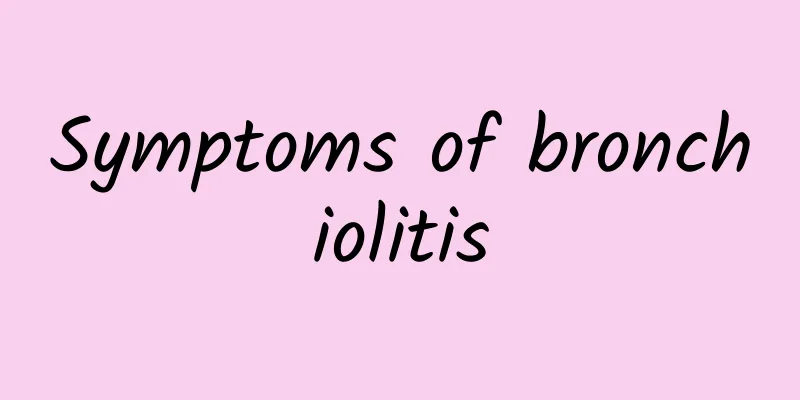Symptoms of bronchiolitis

|
Bronchitis refers to inflammation of the bronchi. It is the most common and serious disease in children is bronchiolitis. The incidence rate is particularly high in winter. The general cause of bronchiolitis is a cold. It is a complication of a cold. Children who have had this disease are prone to relapse. Everyone should know more about the symptoms of bronchiolitis. Do you know the symptoms of bronchiolitis? The most obvious symptom is coughing. Tracheitis is very harmful to patients. If you do not pay attention to the coughing phenomenon in normal times, it is very likely to cause severe bronchiolitis, which will cause greater harm. Clinical manifestations Typical bronchiolitis often occurs 2 to 3 days after an upper respiratory tract infection, with persistent dry cough and fever, moderate to low fever, and wheezing attacks. The condition is more severe 2 to 3 days after the onset of wheezing. Respiration increases significantly during an attack, reaching 60 to 80 times per minute or more, accompanied by prolonged exhalation and expiratory wheezing. Severely ill children show obvious nasal congestion and the "three-depression sign" (i.e., depressions in the supraclavicular fossa, suprasternal fossa, and upper abdomen during inhalation), pale complexion, blueness around the mouth, or cyanosis. Children are often irritable and groaning. Children with more serious conditions may have heart failure or respiratory failure. Most cases can be relieved after treatment, and death rarely occurs. Symptoms (a) Age: Mostly seen in children under 1 year old, especially infants under 6 months old. (2) The disease can occur throughout the year, but is more common in winter and spring. (3) The onset is relatively acute, with early symptoms of a cold, such as coughing and sneezing. After 1 to 2 days, the cough worsens, and paroxysmal dyspnea, wheezing, pale complexion, cyanosis of the lips, and the three-recess sign appear. The early lung signs are mainly wheezing, followed by moist sounds. When symptoms are severe, they may be accompanied by congestive heart failure, respiratory failure, hypoxic encephalopathy, and water and electrolyte imbalances. The body temperature usually does not exceed 38.5℃, and the course of disease is 1 to 2 days. week. (iv) White blood cell count is mostly normal or slightly increased. Blood gas analysis may reveal hypoxemia and decreased or increased partial pressure of carbon dioxide in arterial blood. Chest X-rays show thickened lung texture, increased translucency of both lungs or small shadows and atelectasis. If conditions permit, rapid virus diagnosis of respiratory secretions can be performed to identify the type of virus. Disease characteristics The onset of bronchiolitis can be acute or chronic. Most of the patients first have symptoms of upper respiratory tract infection, and may also suddenly develop frequent and deep dry coughs, followed by gradual bronchial secretions. Infants and young children do not expectorate and usually swallow the pharynx. Those with mild symptoms have no obvious signs of illness, while those with severe symptoms have a fever of 38-39°C, occasionally reaching 40°C, which usually subsides within 2-3 days. Feeling tired, affected sleep and appetite, and even gastrointestinal symptoms such as vomiting, diarrhea, and abdominal pain. The older child complained of headache and chest pain again. The cough usually lasts for 7 to 10 days, sometimes lingers for 2 to 3 weeks, or recurs. If not properly treated, it may cause pneumonia. White blood cell count is normal or slightly low, and those with elevated white blood cell count may have secondary bacterial infection. Complications are rare in healthy children, but in children with malnutrition, low immune function, congenital respiratory tract malformations, chronic nasopharyngitis, rickets, etc., they are not only prone to bronchitis, but also prone to complications such as pneumonia, otitis media, laryngitis and sinusitis. Everyone should know the symptoms of bronchiolitis. Bronchiolitis is also very serious and has a great impact on children. If parents find that their children have this symptom, they should be able to walk their children in time. If they are not treated in time, it will cause many complications, such as bronchopneumonia. |
<<: Symptoms of chronic renal failure
>>: What is the reason for no fetal heartbeat?
Recommend
What medicine can improve sexual ability?
Proper sexual life is beneficial to physical and ...
What is cinnamon
Do you know what kind of food cinnamon is? Have y...
What should I do if I feel chest tightness and air stuck in my throat?
When our body feels uncomfortable, we can first d...
What to do if there is blood clot in the calf
It is also common to have blood clots in the calv...
What are the effects of hot compress with coarse salt? What are the effects of hot compress with coarse salt
It can promote blood circulation and remove blood...
Causes of pain in the lower left abdomen of women
Women have more physical conditions than men. Man...
What to do if polyps grow on the vocal cords
Many people need to pay attention to their diet a...
Causes of Coronary Heart Disease
Coronary heart disease is a disease that falls un...
How much do you know about Chinese medicine?
Many people know that if you are sick and need to...
What happens if fungal infection is serious?
Women's vaginal health is very important. Man...
Male hair loss is mostly caused by these factors
Many men experience hair loss when they reach a c...
What are the symptoms of poor bowel function?
This phenomenon is more common due to poor gastro...
The efficacy of karna powder
Kudzu powder is a food made from kudzu root. It i...
Special effects of Bupleurum chinense
The Chinese medicinal herb Bupleurum is also call...
What causes jaw pain?
Many friends suffer from chin pain and don’t know...









